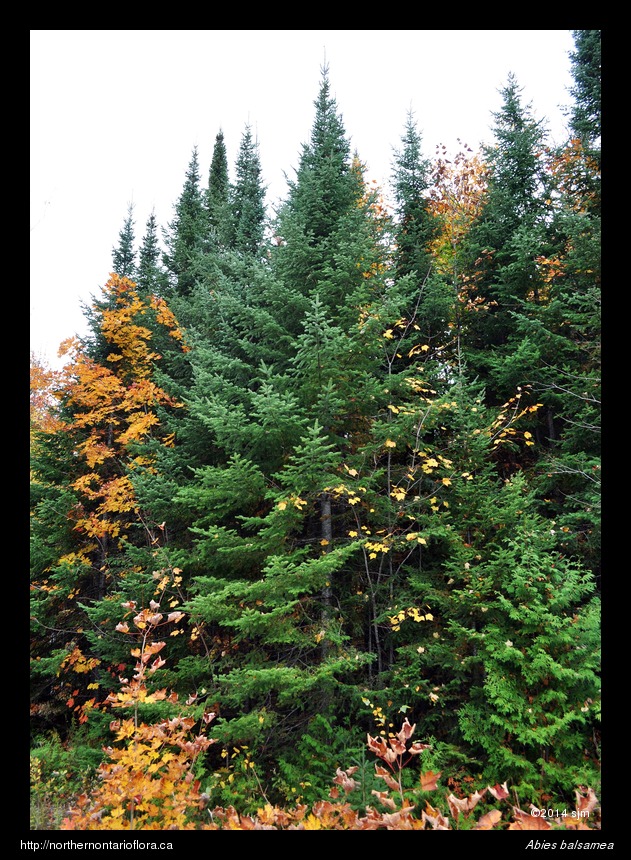
|
Northern Ontario Plant Database 
Plant DescriptionAbies balsamea (L.) Mill.En: balsam fir, Canada balsam, var (NL), balm of Gilead, eastern fir, fir-balsam, blister fir
Pinaceae (Pine Family) General: A tall evergreen tree, to 25 m tall, tapering gradually to a narrow conical spire-like top; trees are shade-tolerant and shallow-rooted. Balsam fir, a dominant tree of the boreal forest, is a favoured Christmas tree species and an important source of pulpwood and lumber. Stems/twigs: Young twigs are grayish to pale brown and slightly hairy; branching is usually opposite. The ovoid buds are brown to dark purplish-black and often coated in resin, obscuring the rows of overlapping bud scales; needle scars are circular. The bark is grayish, fairly smooth, and bears numerous horizontal raised blisters that contain an aromatic sticky resin; older trees have grayish-brown bark separating into small irregular scales. Needles: Evergreen, simple, and sessile. Needles are linear and flexible, 1.2—2.5 cm long by 1.5—2 mm wide, flat in cross-section, glabrous, dark green, and marked below with 2 distinct white lines - one along either side of the midrib; the upper needle surface has a single white line along the middle. Needle tips are blunt to rounded; bases narrow to a flat circular pad; margins are entire. Needles are spirally arranged around the stem, but lower branches have needle bases twisted so that needles appear opposite and flattened in one plane (2-ranked); upper branches have needles twisted upwards. Terminal and upper shoots have stiff spirals of pointed needles, similar to spruce, but the circular pads at the needle bases distinguish fir from spruce. Reproductive structures/cones: Unisexual, with both male and female reproductive structures (cones) borne on the same plant (monoecious). Male cones originate from the leaf axils of the previous year's needles; the male cones are small and ovoid, but become pendant as pollen is shed. Female cones are cylindrical, 4—7 cm long by 1.5—3 cm wide, erect, and clustered along the top of the upper branches. Immature female cones are reddish-purple, becoming brown at maturity. Bracts subtending the obovate cone scales in the typical variety (var. balsamea), are usually shorter than the scales and thus not visible. But plants classified as var. phanerolepis Fernald have longer bracts with slender tail-like tips that stick out beyond the edge of the cone scales. Seeds are 3—6 mm long with a thin obovate wing about twice as long as the seed. Balsam fir cones mature in one growing season. When their seeds mature, the deciduous cone scales and bracts fall with the dispersing seeds, leaving the persistent cone axis standing erect along the upper branches. Habitat and Range: Mixedwood and coniferous forests, on a variety of soil and site types. Balsam fir is a boreal North American species; its Canadian range extends from Newfoundland and Labrador to Alberta. In Ontario, it extends across the Province, throughout the Algoma District, and north to the Hudson Bay Lowlands. Similar Species: Like balsam fir, the needles of eastern hemlock (Tsuga canadensis) (L.) Carrière are flat and arranged along both sides of the branches, but the needles of eastern hemlock are smaller, have minutely toothed margins near the apex, and narrow abruptly at the base to a slender petiole, attached to a decurrent woody base. Canada yew (Taxus canadensis Marshall), a low evergreen shrub, also has soft flat needles, but yew needles have pointed tips and decurrent bases on green stems. Back to species list |
||||||||||||||||||||||






















